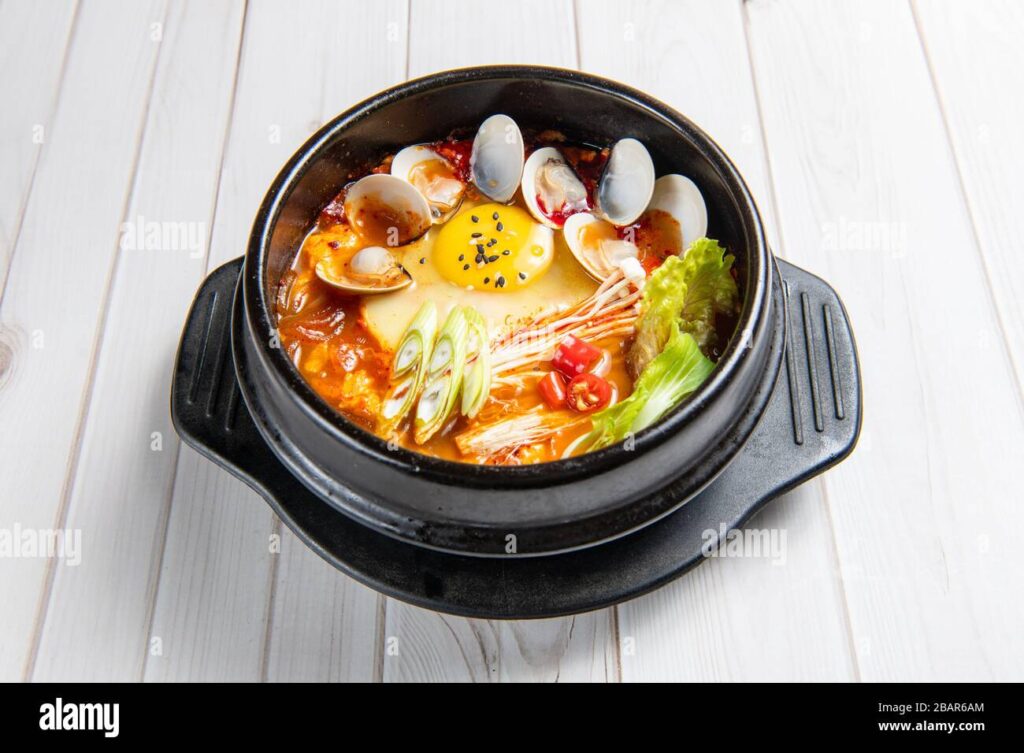Dive into the vibrant flavors of Korea with Kimchi Jjigae, also known as Korean Kimchi Stew! This iconic dish is a comforting and flavorful stew made with fermented kimchi, pork (or tofu for a vegetarian option), and a variety of other ingredients. It’s spicy, savory, and packed with umami, making it a perfect meal for a cold day or any time you’re craving something bold and satisfying. Our comprehensive guide will walk you through each step of creating this delicious dish at home, ensuring an authentic and enjoyable cooking experience. This Kimchi Jjigae recipe is simple, easy, and delicious!
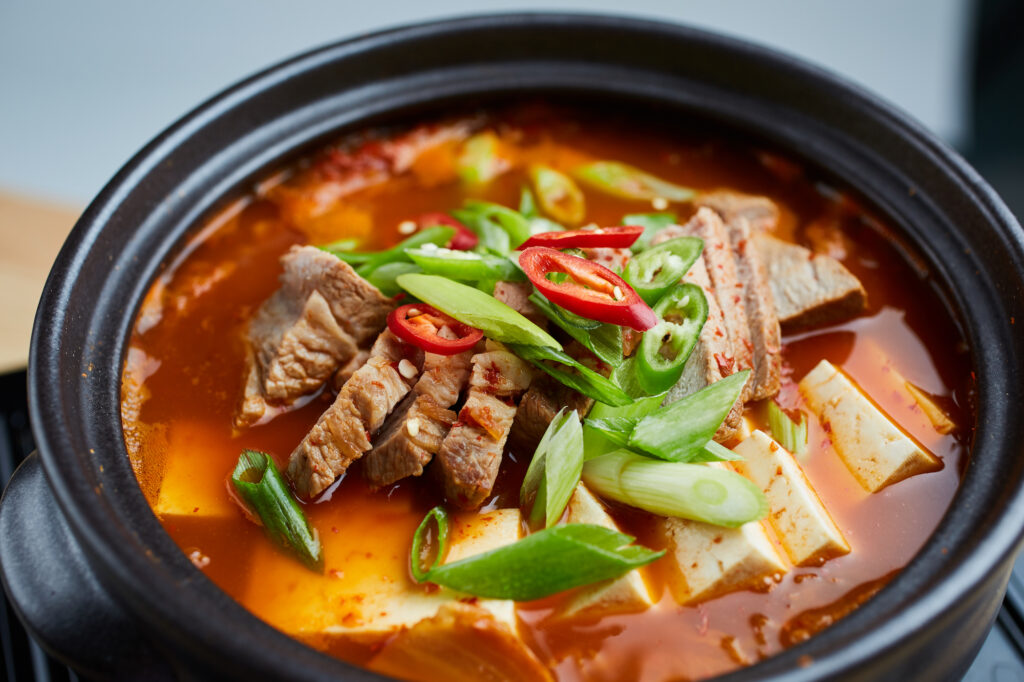

Kimchi Jjigae Recipe Overview
| Category | Value |
|---|---|
| Preparation Time | 20 minutes |
| Cooking Time | 30 minutes |
| Servings | 4 servings |
| Difficulty | Easy |
Nutritional Information (per serving, approximate)
The nutritional information for Kimchi Jjigae can vary widely based on the specific ingredients and quantities used. However, a typical serving (approximately 1.5 cups) may contain the following:
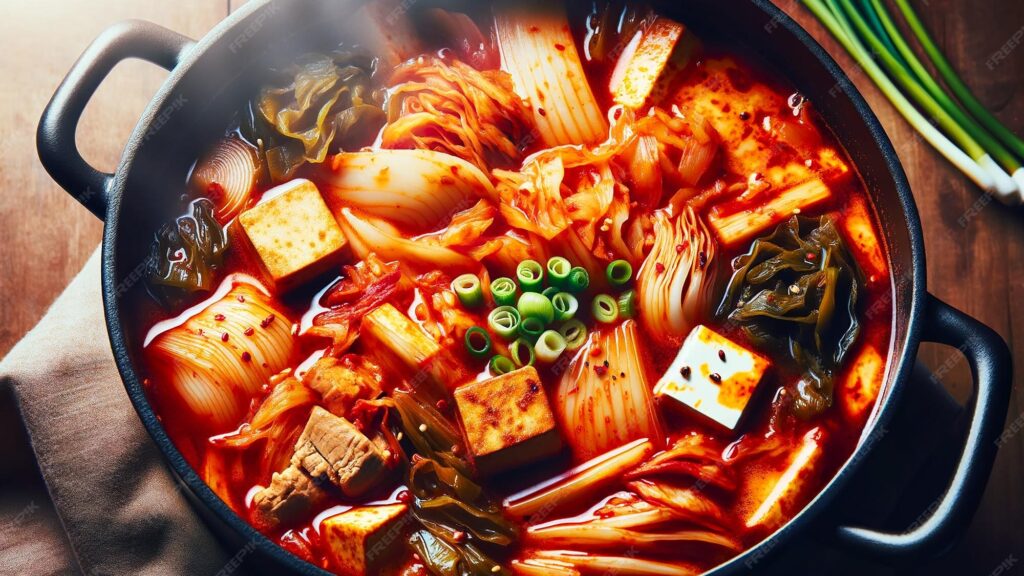
- Calories: 300-400
- Protein: 20-25g
- Fat: 15-25g
- Carbohydrates: 15-20g
- Sodium: 1500-2000mg (Kimchi is high in sodium)
Kimchi Jjigae Ingredients
| Ingredient | Quantity | Notes |
|---|---|---|
| Kimchi | 1 ½ cups, cut into bite-sized pieces | Use well-fermented, sour kimchi for the best flavor. |
| Pork Belly (or Tofu) | ½ lb, thinly sliced | Substitute firm tofu for a vegetarian option. |
| Onion | ½ medium, thinly sliced | Yellow or white onion works well. |
| Garlic | 2 cloves, minced | Freshly minced garlic is recommended. |
| Green Onions | 2, thinly sliced | For garnish and added flavor. |
| Korean Chili Powder (Gochugaru) | 1-2 tablespoons (adjust to taste) | Adds spice and vibrant color. |
| Korean Chili Paste (Gochujang) | 1 tablespoon | Adds depth of flavor and spice. |
| Soy Sauce | 1 tablespoon | Adds umami and saltiness. |
| Sugar | ½ teaspoon | Balances the flavors and adds a touch of sweetness. |
| Sesame Oil | 1 teaspoon | Adds aroma and flavor. |
| Water or Broth | 4 cups | Chicken or vegetable broth adds more flavor than water. |
| Tofu (optional) | ½ block, firm or silken, cubed | Adds protein and texture. |
| Mushrooms (optional) | ½ cup, sliced (e.g., shiitake, enoki) | Adds earthy flavor. |
| Rice Cakes (optional) | ½ cup, sliced | Adds chewy texture. |
| Ramen Noodles (optional) | 1 package | Adds substantial texture and heartiness. Add near the end of cooking. |
Cooking Instructions: How to Make Authentic Kimchi Jjigae
- Sauté the Pork (or Tofu): In a large pot or Dutch oven, heat a teaspoon of sesame oil over medium heat. Add the sliced pork belly (or tofu) and sauté for 3-5 minutes, or until lightly browned. If using tofu, press out excess water before adding to the pot to help it brown better. Pork belly adds rich flavor to the Kimchi Jjigae.
- Add the Kimchi and Onions: Add the chopped kimchi and sliced onions to the pot. Stir well to combine with the pork (or tofu). Sauté for another 3-5 minutes, allowing the kimchi to soften and release its flavors. The sourness of the kimchi is key to an authentic Kimchi Jjigae.
- Introduce the Aromatics: Add the minced garlic to the pot and stir for about 30 seconds until fragrant, being careful not to burn it. Garlic is essential to the classic flavor profile of Kimchi Jjigae.
- Add Seasoning and Broth: Stir in the Korean chili powder (gochugaru), Korean chili paste (gochujang), soy sauce, and sugar. Mix well to ensure the spices are evenly distributed. Pour in the water or broth. Bring the mixture to a boil, then reduce the heat to low, cover, and simmer for 15-20 minutes. Simmering allows the flavors to meld together beautifully in your Kimchi Jjigae.
- Add Optional Ingredients: If using tofu, mushrooms, or rice cakes, add them to the pot during the last 5-10 minutes of simmering. Adjust cooking time to ensure the rice cakes become tender. These ingredients add depth and texture to the Kimchi Jjigae.
- Taste and Adjust: Taste the stew and adjust the seasoning as needed. If you prefer a spicier flavor, add more gochugaru. If it’s too sour, add a pinch of sugar. This is where you can truly personalize your Kimchi Jjigae.
- Garnish and Serve: Ladle the Kimchi Jjigae into bowls and garnish with sliced green onions. Serve hot with a bowl of steamed rice. Enjoy your homemade Kimchi Jjigae!
Serving Suggestions for Kimchi Jjigae
- With Rice: Serve Kimchi Jjigae with a bowl of fluffy steamed white rice or brown rice. The rice helps to balance the spiciness and complements the savory flavors.
- With Side Dishes (Banchan): Serve alongside other Korean side dishes (banchan) such as seasoned spinach (sigeumchi namul), pickled radish (danmuji), and bean sprout salad (kongnamul muchim) for a complete Korean meal.
- With Eggs: Top your Kimchi Jjigae with a fried egg or a poached egg for added richness and protein. The runny yolk adds a creamy texture to the stew.
- As a One-Pot Meal: If you add ramen noodles, tofu, and mushrooms, Kimchi Jjigae can easily become a hearty and satisfying one-pot meal.
- For Gatherings: Kimchi Jjigae is perfect for sharing with friends and family. Serve it family-style from a large pot or Dutch oven, allowing everyone to help themselves.
Tips for the Best Kimchi Jjigae:
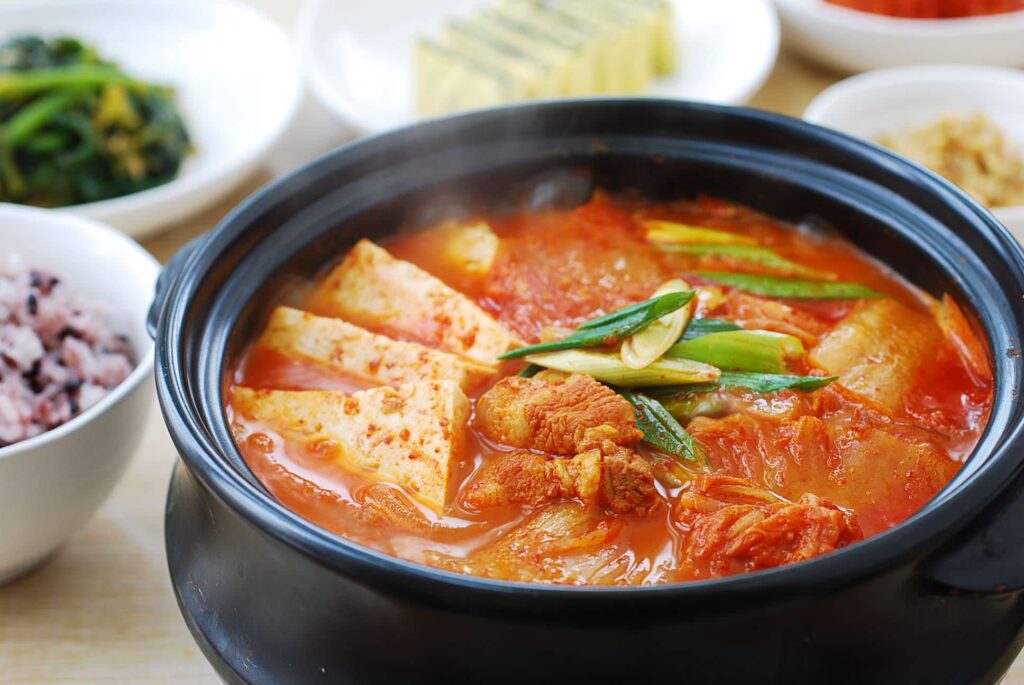
- Use Well-Fermented Kimchi: The key to a flavorful Kimchi Jjigae is using kimchi that is well-fermented and sour. This will give the stew its characteristic tangy flavor. If your kimchi is not sour enough, you can add a splash of vinegar or kimchi juice to enhance the sourness.
- Adjust the Spice Level: The spice level of Kimchi Jjigae can be adjusted to your preference by adding more or less Korean chili powder (gochugaru). Start with a smaller amount and add more to taste.
- Don’t Overcook the Tofu: If using tofu, add it during the last few minutes of cooking to prevent it from becoming too soft or falling apart.
- Experiment with Ingredients: Feel free to experiment with different ingredients to customize your Kimchi Jjigae. You can add other vegetables like zucchini, carrots, or mushrooms. You can also use different types of protein, such as beef, chicken, or seafood.
- Make it Vegetarian: To make a vegetarian Kimchi Jjigae, substitute tofu for the pork and use vegetable broth instead of chicken broth. You can also add mushrooms and other vegetables for added flavor and texture.
- Leftovers Taste Great: Kimchi Jjigae tastes even better the next day as the flavors have had time to meld together. Store leftovers in an airtight container in the refrigerator for up to 3 days.
- Kimchi is the Star: Remember, the kimchi is the most important ingredient! Choose a good quality kimchi for the best results. You can often find kimchi at Asian grocery stores or in the international section of your local supermarket. The better the kimchi, the better your Korean Kimchi Stew will be.
- Adjusting the Broth: If your Kimchi Jjigae is too thick, add more broth or water until you reach your desired consistency. If it’s too thin, simmer it uncovered for a few more minutes to allow some of the liquid to evaporate.
Variations on the Classic Kimchi Jjigae Recipe:
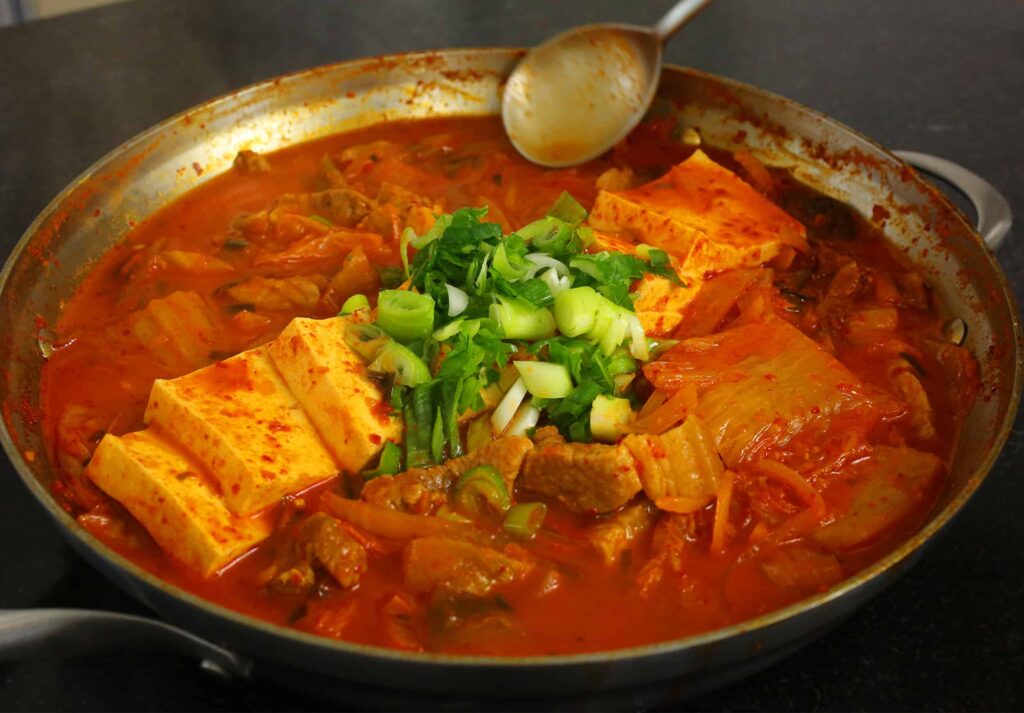
- Seafood Kimchi Jjigae: Add shrimp, clams, or mussels for a seafood twist.
- Budae Jjigae (Army Stew): A fusion stew with ingredients like Spam, hot dogs, and instant ramen noodles.
- Vegetarian Kimchi Jjigae with Mushrooms: Use a variety of mushrooms like shiitake, enoki, and oyster mushrooms to add earthy flavors and a meaty texture.
In conclusion, Korean Kimchi Stew, or Kimchi Jjigae, is a versatile and comforting dish that is easy to make at home. By following this recipe and tips, you can create an authentic and flavorful stew that will impress your friends and family. Don’t be afraid to experiment with different ingredients and adjust the seasoning to your liking. Enjoy the bold and spicy flavors of Korea with every spoonful of your homemade Kimchi Jjigae! The key to a perfect Kimchi Jjigae lies in the quality of the kimchi and the balance of flavors. So, grab your ingredients and start cooking!
